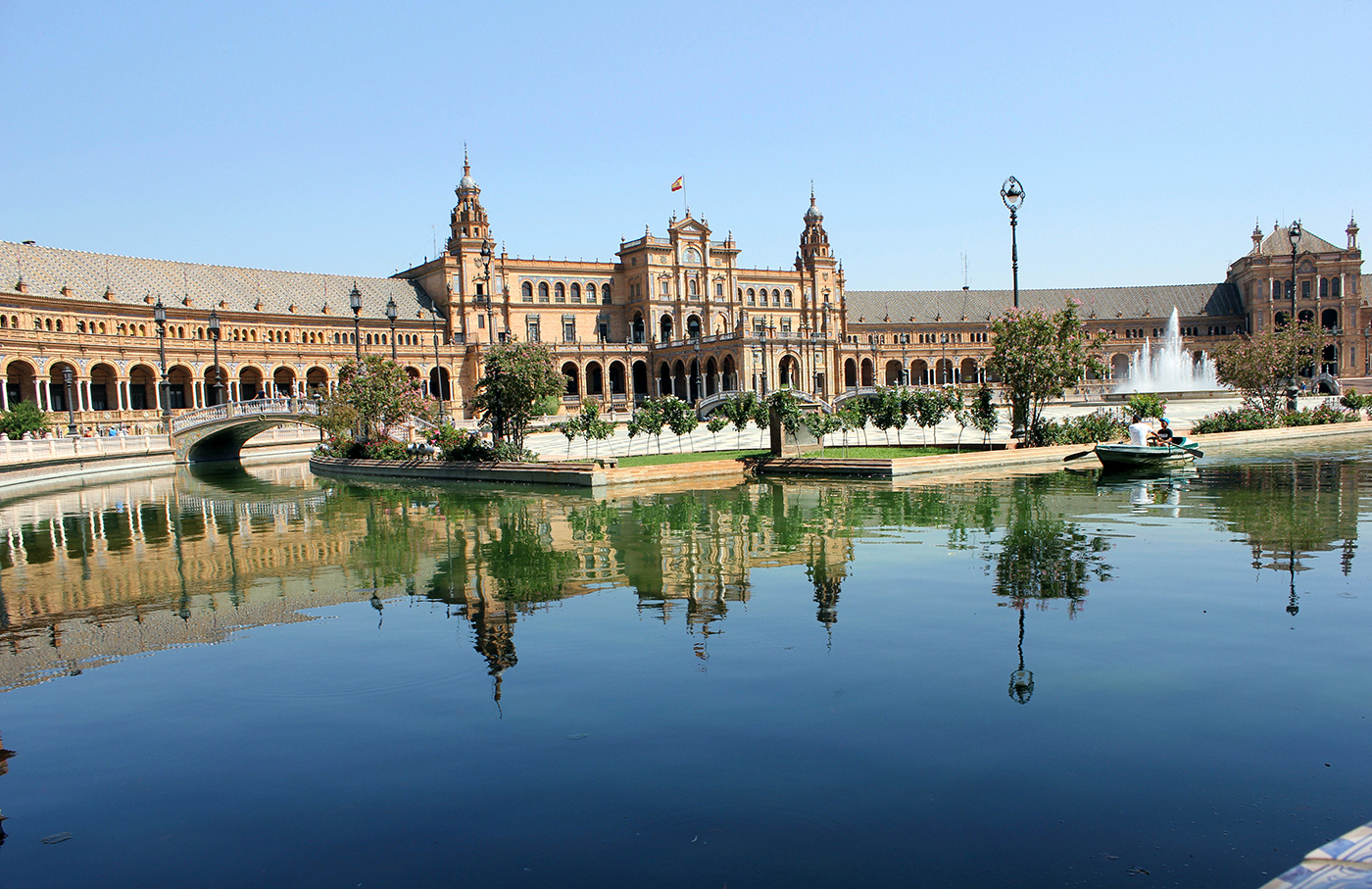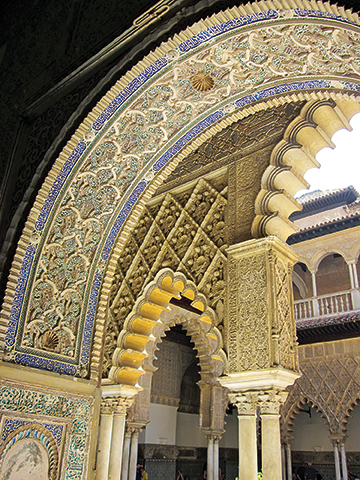
Architecture detail. Photo: Liz Crompton.
Southern Spain is a heady mix of influences at the junction of Europe and Africa, Atlantic and Mediterranean. What’s not to fall for?
By Liz Crompton Plaza de España, Seville. Photo: Christine Allard.
The first person I met on my first trip to Spain was Carolyn, an American who lived in Texas. She had been on my flight from Madrid to Seville, and we began chatting while we waited for our luggage to lumber onto the airport carousel. She told me it wasn’t her first trip to Andalucía, Spain’s sun-drenched southernmost region, but it might be her last.
With a bit of prompting, and after a heavy sigh, Carolyn outlined the reason for her journey. She’d done the Spanish version of Under the Tuscan Sun, falling in love with a place while on a trip and buying a fixer-upper. But unlike Frances Mayes, the American author of that memoir, Carolyn hadn’t overcome the challenges. She was there to “break up”—to sell her house and move on.
I, on the other hand, remained optimistic. There were many good reasons to fall for this junction between Southern Europe and Northern Africa, between the cool Atlantic and the fiery Mediterranean. From this boisterous mix of influences, for example, comes the guitar, an instrument that can evoke so many moods; flamenco, a complicated and demanding dance set to a complex cross of Arab and gypsy rhythms; and gazpacho, a spicy cold puréed vegetable soup that perfectly counters the searing heat of summer.
I’d become aware of this part of Spain because of, of all things, a 1980s British television series about Robin Hood. That version of the classic tale featured among its band of Merry Men a Moor, Moors being Muslims from North Africa who had conquered this part of Europe in the early 8th century. Later on, photographs revealing exquisite architecture across this exotic landscape began to seduce me.
Like going on a first date armed with some pictures and an incomplete biography of the other person, I finally left for southern Spain with little but the memory of a TV character, a Lonely Planet guidebook, and a pocket guide to Spanish.
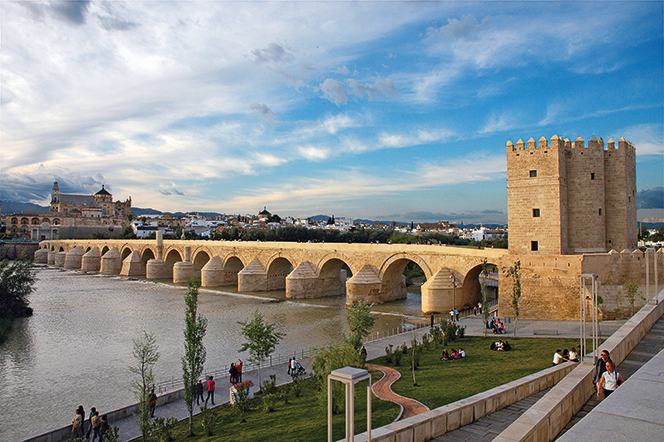
The Roman bridge over the Guadalquivir river in Córdoba. Photo : Turismo de Córdoba.
PHASE 1: Getting to Know You
The process of exploring an unfamiliar city in person is indeed rather like dating someone new: you get a superficial overview first, then spend time on the features that grab your attention. Not everything you find will appeal to you, but that’s the messiness of places and people alike: it’s a blend of character, temperament, and the sum of decisions and experiences, good and bad, that amount to a whole worth sticking with or not.
I spent three days getting to know Seville, Andalucía’s capital and biggest city, and one day each in Córdoba and Granada. First, I wanted to dig a little bit into my subject’s background. How had it come to be what it is today? Who or what had been its biggest influences?
The first people who seemed to have had a lasting impact in what is now Andalucía were the Romans, who arrived in the 2nd century BC and stayed in what they called Hispania Baetica for six centuries. There are still signs of their presence, such as the bridge over the Guadalquivir river in Córdoba, their one-time capital, while the bones of their temple are visible through Plexiglas set in the floor of the Mezquita, a jaw-dropping mosque-cum- cathedral. The Visigoths filled the power vacuum after the Romans withdrew, but left little in the way of visible legacy.
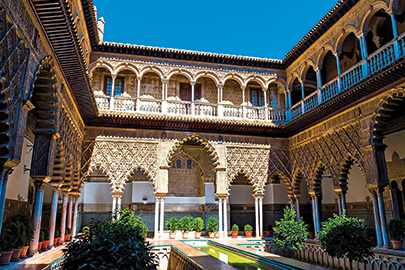
Patio de las Doncellas in Real Alcázar, Seville. Photo: Fotolia/Alena Stalmashonak .
The Moors arrived in 711, establishing themselves on much of what is now the Iberian Peninsula and naming their new lands Al-Andalus. They also chose Córdoba as their seat of rule, but moved it to Granada in the 13th century. There they built the spectacular Alhambra palace and fortress, an architectural jewel that’s one of Spain’s most popular destinations. It was at the Alhambra, the last Moorish foothold, that Muslim rule in Andalucía was decisively ended in 1492 by the monarchs Ferdinand and Isabella. Christian rule over the region was then complete.
Andalucía enjoyed prosperous times for many centuries under Roman, Muslim, and early Christian rule, when exotic goods such as chocolate, coffee, potatoes, and tobacco from the New World began to flow into Europe through the port city of Seville. But the good times didn’t last. In fact, an article in The Guardian a few years ago referred to Andalucía as a “historically poor” part of Spain, and the area is still shaky from the repercussions of the global financial crisis. But is lesser fortune a good reason to write off a place? Perhaps for someone more interested in a high-octane metropolis, but Andalucía still has good features to recommend it.
PHASE 2: Infatuation
What first charmed me were the narrow streets of Seville’s old city centre. Never straight, they sometimes funnel their travellers onto more streets and sometimes deliver them into squares presided over by grand buildings. And sometimes they’re racetracks: one evening, I came across what looked to be a rollerblading race. A column of skaters of all levels of proficiency burst out of a small street and into a square, whizzed by, and disappeared up another street.
Many of the tall houses lining the streets cheek-by-jowl look rather nondescript, but there’s often another world behind the facade. I fell into the habit of looking through front doors because many open onto enclosed patio gardens, little oases of plants and outdoor furniture and sunshine.

The Metropol Parasol. Photo: Turismo de Sevilla.
The tiles used abundantly in architecture in Seville caught my eye in particular. Most often blue and white and sometimes with accent colours, they provide a visually cool counterpoint to the often warm-coloured buildings and a physically cool one to the summer heat. A magnificent example of the ceramics industry is the Plaza de España, built for the Ibero-American Exhibition of 1929. Anchoring the corner of a large park, it comprises two low building wings at right angles that hug a large plaza. A semicircular moat extends between the tips of the outstretched wings. Tiles pock the red building and line the bridge and railings by the moat and other water features, together conjuring an image that might seem familiar from a fairy tale. Perhaps that’s why the Plaza de España was chosen to serve as the palace of the Queen of Naboo in the Star Wars film Attack of the Clones.
Much as I admired the plaza, it was the Alcázar that got my heart beating faster. One of the oldest royal palaces still in use in Europe, it began life as a Moorish fort in the early 10th century. Evolving over time, it was redesigned for both aesthetics and practicality, which in its environment means heat-reducing tiles, rooms open to airflow, and gardens. The Christian Europeans who came later built to their own style alongside the Islamic one, so the contrasts between designs can be quite striking. In one part of the complex, for example, a Muslim leader received delegates in the Hall of Ambassadors, with its exquisitely decorated walls and show-stopping ceiling, while in the Admiral’s Hall, in a section built for handling trade with the New World, plans were made for some of the world’s greatest expeditions, including the circumnavigation of the globe by Magellan and Sebastián ElCano.
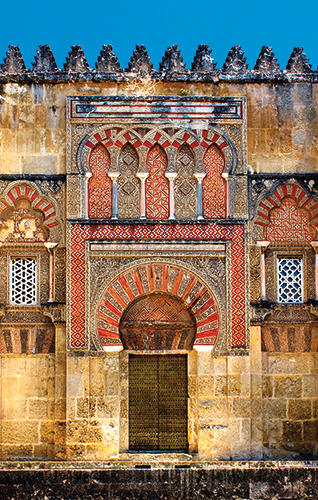
Mosque’s side door, Córdoba. Photo: iStock/Mpaunero10.
The Alcázar, along with the nearby cathedral and the Archivo de Indias, which holds rare documents about the discovery and colonization of Latin America, are now a UNESCO World Heritage Site that together, according to UNESCO’s website, “perfectly epitomize the Spanish ‘Golden Age,’ incorporating vestiges of Islamic culture, centuries of ecclesiastical power, royal sovereignty, and the trading power that Spain acquired through its colonies in the New World.”
Not that old Seville’s architecture is frozen in time. Finished just a few years ago, the Metropol Parasol commands attention as the world’s largest wooden structure. It undulates over a large public square like a massive white waffle held up by stalks.
On another hot sunny morning, I set off by bus to explore Córdoba, about 140 kilometres (87 miles) northeast of Seville. The city’s main attraction is no doubt its Mezquita. A magnificent structure built on the ruins of a Roman temple, it looks unlike the mosques I became familiar with in Istanbul. That may be because it comprised a forest of hundreds of pillars or because it wasn’t centred under a dome. It was hard to tell, as a cathedral had since been built in the middle of it, its soaring towers of light-coloured walls ending in a ring of windows contrasting with the dark coolness of the mosque. The descriptor that kept whispering to me was “split personality.”
While there wasn’t a synagogue in the mix, it may count that the building stands on the edge of the Jewish quarter, a warren of whitewashed buildings with small second-floor balconies erupting with flowers. Letting myself get lost in the ancient maze, I came across a small Moroccan tea house in a tiny shaded courtyard with a fountain. A glass of iced tea hit the spot on an afternoon reaching towards 37°C (98.6°F).

Narrow streets
of Córdoba. Photo: Turismo de Córdoba.
I don’t know if this is unique to Córdoba or if it was because it was Saturday, but the people there seemed incredibly joyful. I happened across no fewer than three groups bursting into song and sometimes dance: a big group of teens who looked to be on a school trip, a small group of men with a guitar gathered outside a café-bar in a lane, and a woman in a polka-dotted flamenco dress.
The following day, I visited Granada. As the Mezquita was Córdoba’s main attraction, the Alhambra and the adjacent Generalife are the highlights of this town. Dominating a hilltop above it, the massive and spectacular palace-fortress complex took several hours to explore properly. While the European conquerors had inserted some of their own buildings inside it, much of the original Muslim architecture and exquisite decoration is intact. Now part of a UNESCO World Heritage Site, it welcomes about three million visitors a year.
Although Granada was the town I felt the least connected to, experiencing the Alhambra was worth the 4½-hour bus journey to and from Seville that day.
PHASE 3: Warts Examined
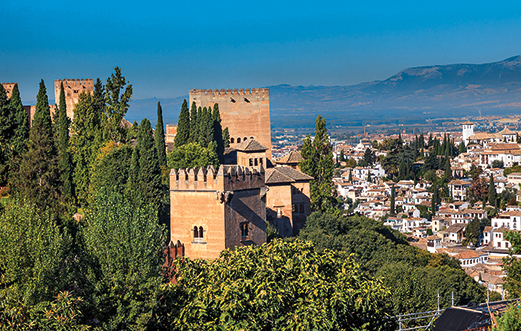
Alhambra Castle and
view over Granada. Photo: Dreamstime/William Perry.
Everyone has some skeletons in the closet. The Inquisition is one that can’t be ignored in Spain. In the late 15th century, Ferdinand and Isabella launched what turned into a brutal witch hunt of anyone suspected of being anything but faithfully Catholic. A passageway near the river in Seville called “Callejón de la Inquisición” and a rather tawdry-looking museum in Córdoba promising displays of instruments of torture reminds one that life there could be cruel for anyone on the wrong side of those wielding power.
Another dark time was that of colonization. From the point of view of the Andalucíans, who for a time enjoyed the European monopoly on trade with the New World, bringing home exotic new things and building an empire overseas no doubt seemed glorious. But the Spanish conquest and subsequent subjugation of the native peoples of the Americas provoked sobering thoughts about the land I was falling in love with. And yet, the horrors of both colonization and the Inquisition had been perpetrated by people long dead—is it fair to hold these acts against their descendants?

The Generalife. Photo: Fotolia/Nikolai Sorokin.
The summer heat is another thing that some may find unappealing. Certainly the country is a great place to seek out during the winter months, but summer in southern Spain? Even the locals of inland towns and cities vacate in July and August for the cool breezes along their long coastline. Residents think it doesn’t start to get hot until it’s 45–50°C (113–122°F), one told me. I was visiting at a time of year during which the average temperature was usually in the mid-20s (around 75°F), but most afternoons I was there, it registered well into the 30s (90°F and above). With that sort of heat, I’d have to leave for months at a time.
History and climate are, however, not within the control of ordinary people to correct. Other things are. Finding out that Seville holds weekly bullfights is like finding out that the object of your affection has a mean streak. However, in the spirit of finding out more about the birthplace of a sport so very Spanish, I visited the Real Plaza de Toros, the “royal place of bulls.”
At roughly 250 years old, it may be the oldest bullring in Spain. The tour guide explained that it’s a team that brings down a bull, not one man; those who confront the bull before the kill are there to bait the animal. Sometimes the bull gets a reprieve if it fights bravely, but most often it ends up in the local butcher shop. One resident said she wished this cruel tradition would stop, but she didn’t think it likely, since it’s a very popular pastime. The best seats go for €150 (about CAD$225).
PHASE 4: Partying Together
Could I make peace with the apparent blood lust of the locals? Apart from this distasteful element, they seemed to have quite a joie de vivre. I felt at a disadvantage not being able to converse fluidly in their language because it made it impossible to connect properly, but it seemed that Andalucíans enjoyed one another’s company a great deal.
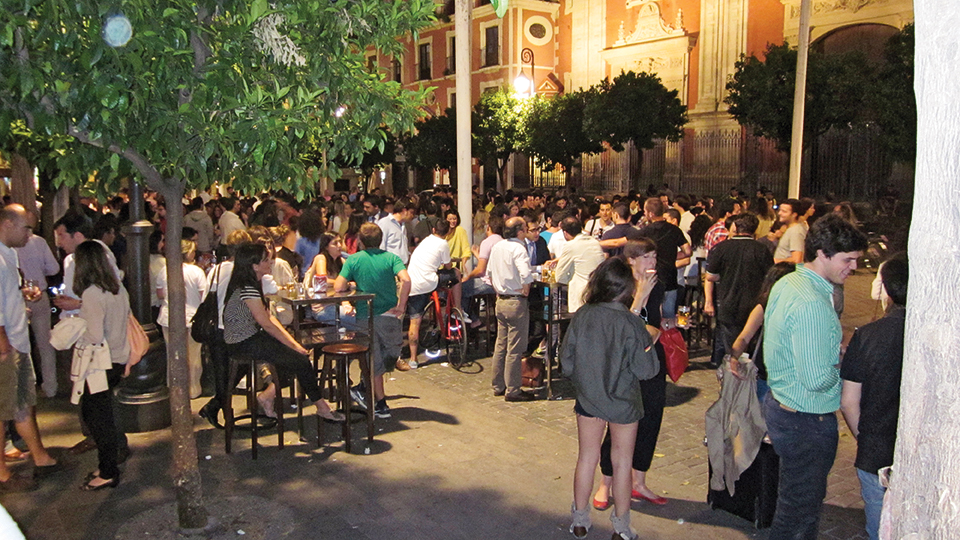
“The swarm” in Seville. Photo: Liz Crompton.
One particularly interesting phenomenon I dubbed “the swarm.” One evening, I was walking through the winding, almost-deserted streets to my hotel after a tasty dinner including paella, a Spanish seafood dish, when I began hearing a faint buzz. The buzz grew louder as I continued on my way. Suddenly I came to a large square packed with people drinking and smoking and chatting spiritedly away. They stood close together in twos, threes, and fours, packed by the many bars as though magnetized. There was a wide-open space available, but they stood close to one another. Hence, the swarm.
The same thing happened in Córdoba, though it was at a bar in a mini-mall in a park during the middle of the afternoon. There was no inkling a party was happening until I was upon it, and then suddenly I was surrounded by a packed crowd smiling, laughing, and talking very quickly and animatedly, the air electric.
I came across other unexpected and delightful examples of local life during my wanderings. One of the highlights was a marching band with about 50 members, young to middle-aged, whom I came across assembling on a side street. They abruptly began playing and strode off, swelling to take up the width of the narrow street. I followed until they stopped in front of an art museum. Waiting in the front yard was a group of children in costume, who acted out a short play after the band had arrived. The amazing thing was that the museum had been my original destination and I’d got a little turned around looking for it; the band had, in a real sense, shown me the way.
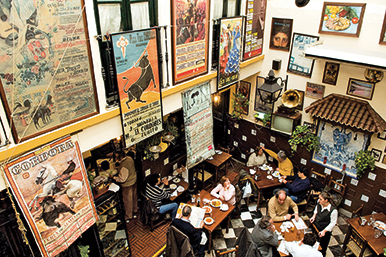
Córdoba Taberna Típica. Photo: Turismo de Córdoba.
PHASE 5: The Decision
It’s time to examine the pros and the cons of Andalucía. Would I come back? It has a rich and complex history, a gorgeous multicultural architectural heritage, delicious food, passionate people, and a beautiful countryside. The warts of economic woe and continued bullfighting are difficult to overlook, but they don’t tip the balance for me. A seductive and complicated land—it’s hard to resist.
Andalucía is definitely at the top of my list. But I should sample a few other places before I commit. Let’s see which other destinations are on my dating short list…


